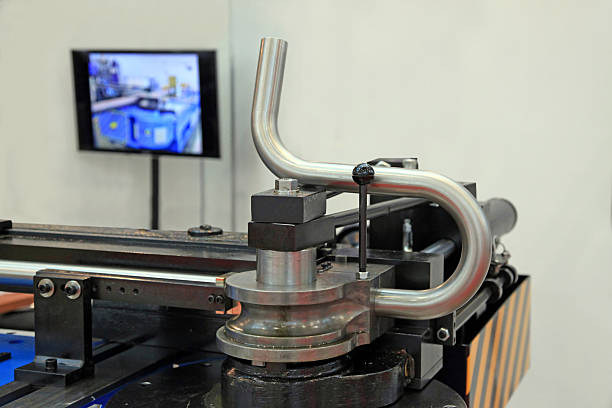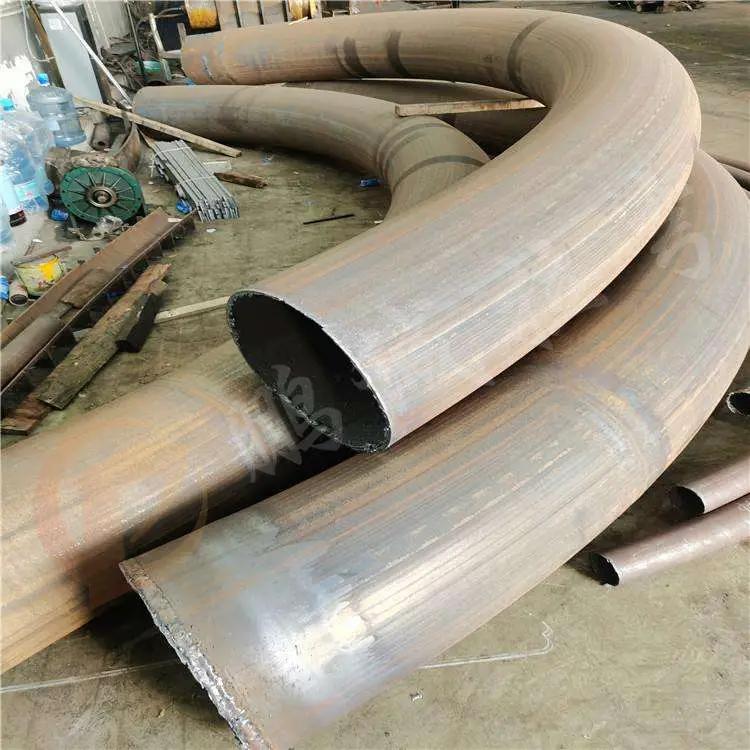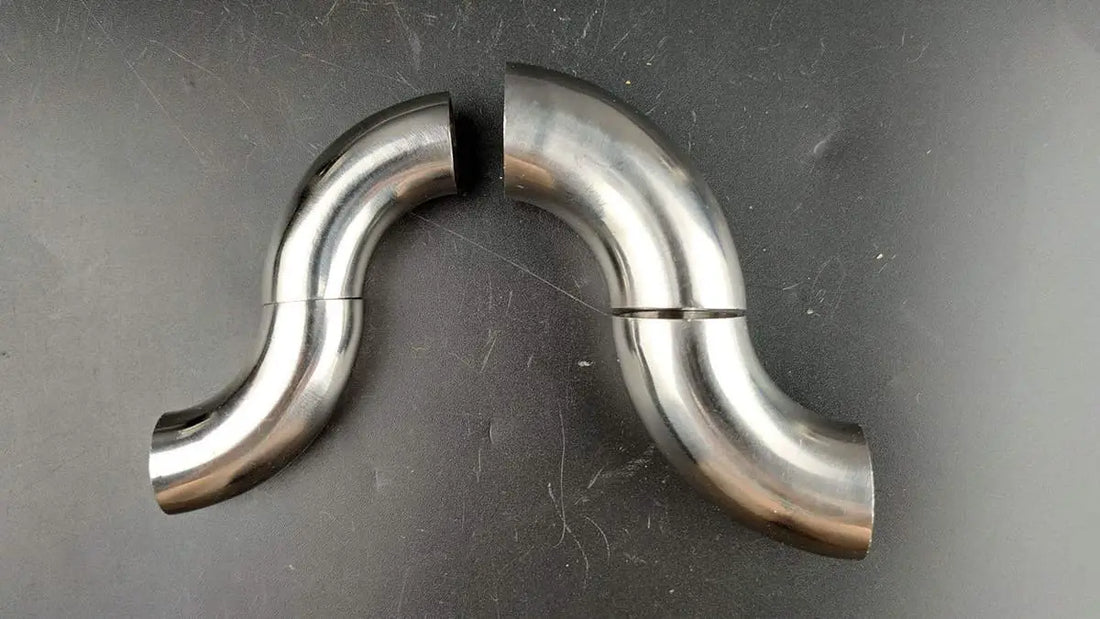I. Basics of Stainless Steel Pipe Bending
Material properties
Stainless steel piping is widely used for various applications due to its corrosion resistance , strength and aesthetic appeal . The material properties of stainless steel vary depending on factors such as alloy composition and heat treatment. It is crucial to understand these properties to ensure successful bending processes.
- Notes : Common types of stainless steel used for pipes include 304, 316, and 409. These types have different mechanical properties, which affect the bending process.
- Hardness : The hardness of stainless steel influences the force required for bending and the potential for cracking. Annealed stainless steel is softer and therefore easier to bend.
- Ductility : Ductility refers to the ability of the material to deform without breaking. Greater ductility leads to smoother bending processes and fewer defects.

Bending Techniques
Various bending techniques can be employed to shape stainless steel tubes, each with its own advantages and limitations. Here are some common methods:
- Mandrel bending : This technique uses a mandrel (a solid rod) inserted into the tube to maintain its shape during bending. This prevents the tube from becoming flat, wrinkled or collapsed. Mandrel bending is ideal for producing curves with tight radii and is popular for automotive and industrial applications.
- Roller bending : Roller bending, also known as pyramid bending, uses three rollers to apply pressure to the tubing, creating a smooth bend. This method is suitable for large radius bends and can accommodate various tube shapes such as square and rectangular tubes.
- Press bending : In press bending, a die and punch apply force to the tube, causing it to bend around a radius of the die. Although this method is relatively simple and economical, it may not produce accurate or precise bends compared to other techniques.
- Heat induction bending : Heat induction bending involves heating the area of the pipe to be bent using an induction coil. Once the desired temperature is reached, the tube is bent using a bending die. Controlled application of heat allows for better flex control and minimized distortion.
When selecting a bending technique, factors such as desired bend radius, material properties and application must be considered. Each method has its advantages and disadvantages, and employing the most appropriate technique will result in the successful bending of stainless steel pipes.
II. Bending Equipment and Tools
When bending stainless steel pipes, it is essential to use appropriate equipment and tools. This section will briefly describe two types of pipe benders: manual and hydraulic, without any conclusion or summary.
Manual tube bender
Manual pipe benders are a popular choice for those who demand precision and affordability. These manually operated devices work by exerting force on the pipe and shaping it into the desired curve. Some features of manual pipe benders include:
- Easy to use: Most manual pipe benders do not require specialized training.
- Portability: They are lightweight and can be carried easily to different work sites.
- Affordability: Compared to hydraulic pipe benders, manual options are generally more economical.
However, manual pipe benders may not be suitable for larger diameter or thicker walled pipes as they require considerable physical strength to operate.
Hydraulic tube benders
Hydraulic pipe benders use hydraulic fluid and pressure to bend stainless steel pipes, making the process more efficient and less labor-intensive. Some advantages of hydraulic pipe benders include:
- Power: They can handle larger diameter and thick-walled pipes with ease.
- Control: Many hydraulic pipe benders offer precise control over angles and bend radii.
- Speed: By using hydraulic power, these press brakes can complete the bending process faster than manual alternatives.
On the other hand, hydraulic pipe benders can be more expensive and require regular maintenance to ensure proper hydraulic fluid levels and smooth operation.
Using appropriate equipment and tools to bend stainless steel pipe is crucial to achieving accurate and consistent results. Manual and hydraulic pipe benders have their respective advantages and limitations, and the choice will ultimately depend on factors such as budget, specific type of piping, and project requirements.
III. What should be paid attention to when bending stainless steel pipes?
Stainless steel industrial piping is widely used in various fluid drainage systems due to its good corrosion resistance, making it a popular choice in environments with high levels of corrosion.
However, when bending stainless steel piping for use in corrosive liquids, it is important to consider the bend radius.
Bending stainless steel pipes is a common form of processing in the industry, but it is not as simple as it may seem. It requires careful study and experience, as different models of stainless steel pipes have different levels of ductility and hardness, with some being more prone to stretching and others to cracking.
1. Reduced ductility
To avoid cracking during bending, it may be necessary to use a larger bend radius when bending in the bending direction. When bending in the transverse direction, the reduced ductility can allow for a tighter inner bend without damaging the outer surface of the bend.
2. Local heating material
When bending thick materials, it may be necessary to preheat the material before bending to make the process easier and reduce the amount of force required.
3. Recovery treatment
Stainless steel piping will spring back when released from the bending force. Springback is the result of the release of elastic deformation, which is directly related to the flow resistance of the material. To achieve the desired bending angle, a larger angle may be required, especially for stainless steel pipes with high yield strength.
The required angular clearance increases with increasing radius, and with a large radius the amount of springback can be significant. If the bent material is rigid, heat treatment may be required.
However, in some cases, the hot bending method can only temporarily achieve the desired bending angle and radius. After the material cools, it may experience a slight springback.
4. Thermoformed stainless steel tube
Hot forming of stainless steel tubes eliminates strain hardening, cracking and deformation and changes its molecular structure through high temperatures.
Compared to cold forming, it is easier to handle hot-formed stainless steel tubes with a bending machine. However, there are limitations to hot forming as heating the stainless steel tube close to its melting point can cause it to break.
High temperature can also lead to oxidation and decarburization of the surface, which can cause several problems for the product. This method is generally used with caution when bending stainless steel pipes.
5. Internal bending radius
For stainless steel industrial pipes, it is necessary to determine the value of the internal bending radius. The radius of longitudinal bending must be greater than that of transverse bending. The hardness and thickness of industrial stainless steel piping determine the required bend radius.
To determine the bending radius, there is a technique that subtracts 50% from the material's stretch rate provided by the supplier.
4. 304 stainless steel round tube bending process

304 stainless steel round tube is a stainless steel hollow round tube that is widely used in various building decoration applications such as fences, stair handrails and patio doors.
The bending process must be smooth, accurate in terms of angle and free from cracks.
Next, I will explain the bending technology for 304 stainless steel round pipes.
1. Round tube bending method
1. Hot bending method:
First, in preparation for bending the 304 stainless steel round tube, clamp the arc carriage rollers on an iron plate based on the outer diameter of the tube. Fill the tube with sand and plug both ends with wooden plugs. Then, preheat the section of pipe that will be bent with a flame.
2. Cold bending method:
Before using the tube bender, it is important to thoroughly test the machine. To avoid cracking, there must be a gap equal to the thickness of the plate at the bottom, and a bend notch with a depth of 8 times the thickness of the plate must be selected.
See too:
- Top 16 Pipe and Tube Bending Machine Manufacturers

2. Technical difficulties
1. During machining, the friction between the workpiece and the tool will generate high heat, and the tool is easy to use.
Therefore, the requirements for tool materials are more stringent, requiring wear resistance and high temperature resistance.
And it must meet the requirements of sharp edges.
2. The bending process is slow and requires great force, leading to low production efficiency.
In addition, due to the high heating capacity, sulfur chloride is generally used as a good refrigerant oil and the effect is better.
Therefore, it is important that workers processing 304 stainless steel round pipes have a good level of experience and technical skill.
3. Precautions
1. Fold:
The general requirements for the bending radius (R) of 304 stainless steel round pipe are that it should be at least 1.5 to 2 times the diameter.
If the radius of curvature (R) is too small, the bend will be flat.
The bending radius (R) of the same stainless steel tube must be consistent to meet the consistency of the wheel die.
The length of the straight edge of the bend must be at least 2 times the diameter, otherwise the bend die cannot be fixed smoothly.
2. Process Orifice:
Process holes should be reserved for welding 304 stainless steel round pipes to better discharge welding slag generated during welding.
3. Processing performance:
First, consider the machinability of 304 stainless steel round tubes.
Stainless steel has high plasticity, toughness, cutting power consumption, cutting temperature, low thermal conductivity, low heat dissipation, and can easily cause the tool temperature to rise.
These factors can affect the bonding and weldability of stainless steel and cause blockages during the cutting process, leading to a reduction in the surface finish of stainless steel pipes.
V. Quality and bending inspection
radius of curvature
The bend radius is an essential aspect of the quality of stainless steel piping. It is the measurement of the curvature of the pipe curvature. The minimum bend radius is determined by the pipe diameter, wall thickness and material properties. Selecting an appropriate bend radius is crucial to avoid deformation, cracking and weakening of the pipeline during the bending process.
- Diameter-to-radius ratio : A common guideline for bend radius is to maintain a diameter-to-radius ratio of 2:1 or greater. A smaller proportion may increase the risk of deformation or damage to the pipe.
- Material Properties : Stainless steel grades have several mechanical properties that affect their ability to be bent without deformation. Factors such as hardness, tensile strength and elongation can influence the minimum bend radius recommendation.
spring back
Springback is the phenomenon in which a bent tube attempts to return to its original shape after being released from bending forces. This can lead to unwanted changes in the angle and radius of the final bend, negatively affecting the overall quality of the bend. Proper inspection and measurement are necessary to ensure the bend meets the desired specifications.
- Bending process : Factors that can impact springback include the type of bending process employed (such as rotary tensile, compression, or rolling), the bending speed, and the material properties of the tube.
- Corrective measures : To compensate for springback, overbending the tube to a slightly higher angle may help achieve the desired final bend angle. This method requires careful calculations and precise control during the bending process.
When inspecting the bend quality in stainless steel pipes, it is vital to ensure that both the bend radius and springback meet the required standards. Employing appropriate bending techniques and taking material properties into account can help achieve accurate, consistent, high-quality bends in stainless steel pipe.
SAW. Troubleshooting and Troubleshooting
Common Bending Problems
When bending stainless steel pipes, it is critical to identify any issues that could affect the final product. Some common flexion problems include:
- Twisting : This occurs when the tubing collapses or bends at the bending point. It is usually caused by improper tooling configuration and can lead to leaks or failures in the final product.
- Ovality : This happens when the tube loses its round profile and becomes oval during bending. It may result from inadequate tooling or excessive force during the bending process.
- Wrinkling : This is characterized by small folds or waves formed along the inner surface of a radius of curvature. It is usually caused by excessive force or insufficient support during bending.
- Spring back : This occurs when the bent pipe returns to its original shape, causing the bend angle to be smaller than intended. It is a natural characteristic of materials, especially those with a high level of elasticity such as stainless steel.
Corrective measures
To ensure longevity, reliability and proper functioning of stainless steel bent pipes, the following corrective measures can be implemented:
- Proper Tools : Use the correct tools specific to the pipe material, thickness and radius. Use suitable dies and mandrels to avoid deformation problems.
- Adequate support : Provide sufficient support during bending to avoid excessive force on the piping material. Use wipers, support blocks and other devices to prevent pipe collapse or distortion.
- Consistent pressure : Consistent pressure and controlled force during the bending process will help maintain the shape and shape of the tube. Avoid applying too much or too little pressure as this may result in folds or wrinkling.
- Optimize bending settings : Adjust bending machine settings. Adjust pressure, speed and other factors to achieve the desired bend radius without compromising the integrity of the pipeline.
By implementing these corrective measures, it is possible to mitigate common bending problems and maintain the desired quality in stainless steel pipe products.
VII. Folding Standards and Guidelines
Industry Codes
There are several industry codes and standards that apply to stainless steel pipe bending. These codes ensure that bending processes achieve accurate and reliable results. Some prominent industry codes and standards include:
- ASME B31.1 : This standard covers the requirements for power piping, which includes the bending of stainless steel piping.
- ASME B31.3 : This standard focuses on process piping, which also includes the bending of stainless steel piping.
Adherence to these industry codes and standards ensures that stainless steel bent piping will meet required structural and performance specifications.
Material Specifications
When bending stainless steel pipes, it is crucial to consider the material specifications that will affect the final product. Some of the essential material specifications include:
- Stainless Steel Grade : The grade will determine the material properties such as corrosion resistance and ductility. Common grades used to bend stainless steel pipe are 304, 316 and 321.
- Pipe Dimensions : The outside diameter and wall thickness of the pipe play a critical role in determining the required bending radius and the overall success of the bending process. Typically, higher wall thicknesses require larger bend radii to achieve optimal results.
Selecting the appropriate material specifications for stainless steel piping is essential to achieving the desired performance and structural characteristics in the final bent product.

























































